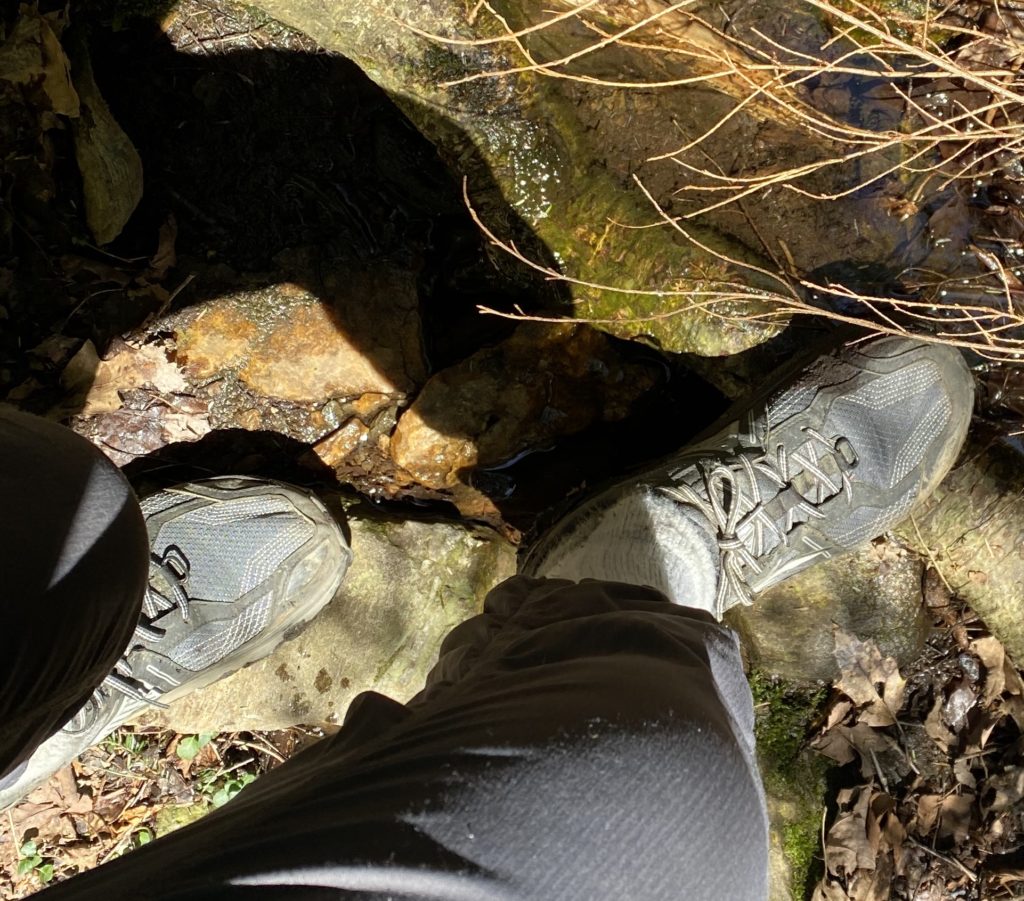Here’s the summary: So far, I’ve worn these for more than 100 miles, including a 12.5 mile day with nearly 2000 feet of elevation gain, and an overnight backpack. They show no signs of wear and haven’t given me so much as a hint of a blister. In fact, I forgot my blister kit on yesterday’s 8-mile A.T. hike — something I usually don’t forget — and when I realized it, I just shrugged. I wasn’t worried — and I didn’t nee to be. I just ordered a second pair, this time, of the most recent version of them.
Over the years (okay, decades) I’ve hiked and backpacked using a variety of shoes and boots. My long-time boot of choice was the Danner Mountain Light, an old-school Vibram-soled leather boot that weighs — in today’s iteration — about 4 pounds per pair. (My old ones weigh 3 1/2 pounds — like people, I guess this is gear that gains weight as it ages). Several pairs carried me on trails around the world for way over 15,000 miles, mostly with no blisters. Back then, every time I tried to lighten up my footwear, my feet paid the price. A pair of fabric and suede boots caused an inflammation in my Achilles tendon so severe that my doctor demanded to know what I’d done to myself. With lightweight trekking shoes, I developed heel spurs and plantar fasciitis that almost put an end to my P.C.T. thru-hike. I never knew what the issue was — maybe fit or shape or support. Each time, I returned to the Danners and my feet were fine again. But the Danners were heavy. Now that my packweight is down to a base weight of about 12 – 13 pounds, I’m again experimenting with trekking shoes — and this time, they are working for me.
Note that choosing trekking shoes over boots is a better choice for hikers with lightweight packs, especially on trails that are rock- or scree-strewn. Everyone is different, but if you’re still carrying 30 or 40 pounds, boots may be a better option.
Here are some details about the Altra Lone Peak Trail Runners, which I’ve been wearing on my recent hikes on the A.T. in Massachusetts and Vermont.
They are famous for the wide toe box. I have a wide foot, but the Altra medium sizing, with its unusually voluminous toe box, fits just fine. (They also make a wide size, but I didn’t feel I needed that.) Of course, fit is the most important element in deciding on a shoe. So order from a place where you can return shoes that don’t fit correctly. You’re looking for plenty of toe room (to avoid banging against the front of the shoe), decent arch support, and a heel that doesn’t slip, especially when you walk uphill. If the fit isn’t perfect at first, you can experiment with different sock and lacing combinations.

I always hike in polyprophylene liners and a wool outer layer sock for cushioning. With old school hiking boots, that wool outer layer has long been a pair of Thorlo hiking socks. I’ve been loathe to change them, because I used Thorlo socks every day on the entire Appalachian Trail without a single blister.
But things change: With the Altras it didn’t feel like I needed such a bulky sock. I kept the polypro liners and changed to a mid-weight Darn Tough trekking sock, which took up a bit less space in my shoes while still offering some nice comfy cushioning underfoot.
My feet felt fine for the whole backpacking trip, even when I slipped and got one foot totally immersed in a stream — the next morning, I put on the still-damp sock and the still-damp shoe, and hiked on. I didn’t even notice the difference.
I still have to see how my feet deal with a whole day of rain, when the shoes and socks will get — and stay — soaking wet. I’ll update when that happens.
One concern I had was how well these shoes would do in muddy spots and bogs. Turned out that they have a tiny bit of height, which was enough that as long as I was careful in how I placed my weight, I never got mud-soaked and wet. (Gaiters helped; I added those on later hikes.)
The other concern I had was traction: how well would the shoes stick on rock — especially wet rock on steep slopes. This turned out to be a non-issue: the soles boast no-slip treads, and I felt very secure, even on slick and wet spots.
Side note: not pictured, but I’ve been using low-rise Salomon gaiters to keep dirt and pebbles out of the shoes. I also just got a pair of the popular Dirty Girl gaiters. Those have a sewn-in Velcro strip at the back, and they come with a strip of adhesive Velcro that you are told to stick on the back of your shoes, just over the heels. This allows you to secure the back of the gaiter to the back of your shoe it won’t ride up. But the Altras actually have a built in Velcro “gaiter trap” that the Dirty Girl gaiters can attach to! It’s the kind of thoughtful feature that tells me these shoes are truly designed for serious on-trail use (as opposed to “athleisure” fashion).
